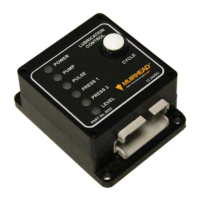M0588.docx | Rev 1.5 | Modified on 12/11/2018 | © Remote Control Technologies Pty Ltd
Options
The options in the options section directly below the inputs section affect how the device behaves.
Figure 12 Options section for a lube controller
No. Option Description
1 Lockout Pump
Cycles
When enabled, the lubrication pump is locked out after an open failure. Manual
lubrication cycles are permitted when the lubrication pump has been locked out.
The number of manual cycles can be configured. If any of the manual lubrication
cycles succeed, the device returns to operational mode. Otherwise, the device
can be reset by cycling the power off and then back on.
2 Lube at Power-up When enabled, a lubrication cycle is activated as soon as power is applied.
3 Alarm Output When this option is set to ‘Pulsed’, the alarm output pulses once every 10
seconds when the lube controller is detecting a low grease fault. Otherwise,
when this option is set to ‘Continuous’, the alarm output is on continuously when
the lube controller is detecting a low grease fault.
4 Pulse Low
Grease Output
When this option is set to ‘Pulsed’, the low grease output pulses twice every
second when the lube controller is detecting a low grease fault. Otherwise, when
this option is set to ‘Continuous’, the alarm output is on continuously when the
lube controller is detecting a low grease fault. It should be noted that the external
manual lube input must be disabled and the low grease output must be enabled.
5 Two Lube Banks When the two lube banks option is set to ‘Present’, the lube controller will operate
two lubrication banks by operating as a swap circuit. The pulse functionality is
disabled as the output is instead used to drive a swap solenoid. A pressure
switch is needed for each grease bank. When the two lube banks option is set
to ‘Not Present’, the lube controller will operate only the first lubrication bank.

